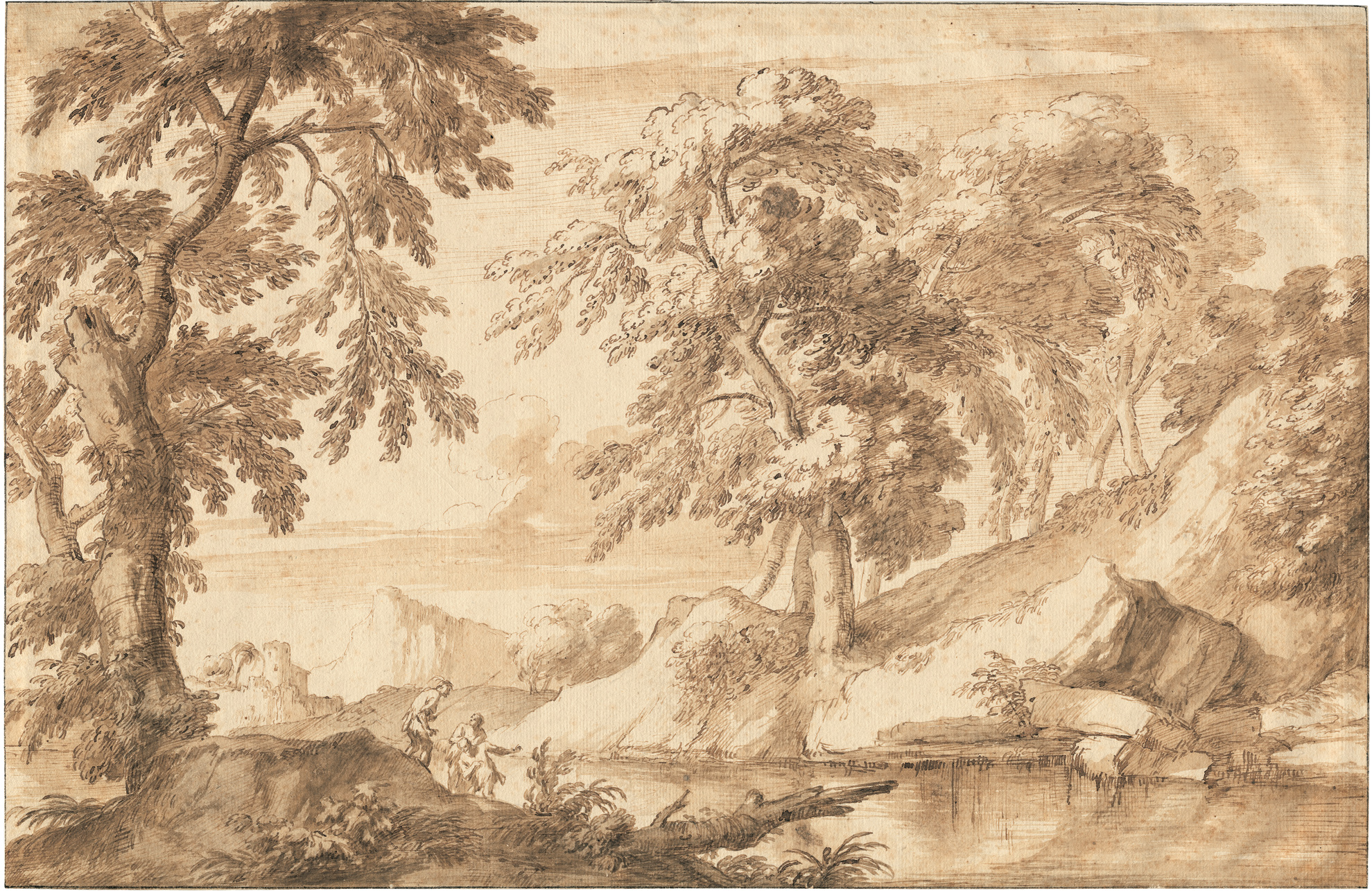Loading the page ...
Andrea Locatelli
(1695–1741, Rome)
Wide Campagna Landscape, in the foreground three men on the bank of a small river. Pen and brown ink over pencil, brown wash, with a borderline in pen and brown ink. 30.5 x 46.5 cm. Watermark: Countermark letters IV.
Andrea Locatelli received his earliest artistic education in Rome from his father Giovanni Francesco, whose activity as a painter is largely undocumented. At the age of twelve, Andrea was apprenticed to the obscure marine painter Monsù Alto, from whom only a few paintings have survived. Afterward, he studied, together with his painter friend Paolo Anesi, under Bernardino Fergioni. By 1723, Locatelli was already referred to by his contemporary biographer Nicola Pio as maestro and director of a flourishing workshop. Locatelli was much in demand, receiving many commissions from such Roman art lovers and connoisseurs as the noble Ruspoli, Albani, and Ottoboni families, as well as from foreigners who visited Rome on the Grand Tour. During this time, Locatelli maintained contact with leading contemporary artists like Pompeo Batoni, Corrado Giaquinto, and Pierre Subleyras. Despite his undisputed fame as a landscape painter, Locatelli apparently died in great poverty, according to the famous marchand-amateur Pierre-Jean Mariette. This is surprising, considering that on occasion Locatelli received higher payment for his commissions than his famous contemporary Giovanni Paolo Panini. In his authoritative monograph on the artist, Andrea Busiri Vici describes a slow degenerative illness as the cause of Locatelli’s untimely death. The handwritten annotation by Pier Leone Ghezzi on a drawn portrait of the artist confirms this: “Il detto Lucatelli morì il 20 di Febraro 1741 in età di anni 48 et è morto spiantato senza un Giulio [a Roman coin] et è lassato la moglie con molti figli miseramente et è morto di gettito di sangue” (A. Busiri Vici, Andrea Locatelli e il paesaggio romano del Settecento, Rome 1976, p.11). After his death, Locatelli’s landscape art was soon forgotten in Italy.
During his lifetime, Locatelli was overshadowed as a painter of Italian landscapes by Jan Frans van Bloemen, called Orizzonte (1662–1749). A Flemish émigré and Locatelli’s older contemporary, van Bloemen became the artistic heir of Gaspard Dughet. Locatelli initially worked in the spirit of van Bloemen, but his pastoral landscapes soon developed a more free and spontaneous style, characterized by a rich and varied use of color. Those paintings reflect the combined influence of Salvator Rosa, Giovanni Ghisolfi, and the Dutch painter Jacob de Heusch. In turn, Locatelli’s balanced, harmonious landscapes influenced not only such immediate followers as Paolo Anesi, Paolo Monaldi, and Giovanni Battista Busiri, but also French masters like Lallemand, Vernet, and Hubert Robert. Today, Locatelli is acknowledged as one of the most important landscape painters of seventeenth-century Italy.
Drawings by Locatelli are exceedingly rare. The catalogue raisonné by Busiri Vici lists only twenty-three drawings, among them several sheets of questionable attribution, leading to the conclusion that the industrious Locatelli painted his landscapes directly onto canvas without relying upon preparatory studies. The present large, finished drawing therefore assumes a special position within the drawn oeuvre of the artist, and was probably intended as an autonomous work of art.
A central problem in establishing Locatelli’s drawn oeuvre, which shows a great number of artistic influences, is his stylistic proximity to such contemporaries as Busiri and Panini. Also notable are close stylistic parallels to drawings by Isaac de Moucheron, who worked in Rome from 1694–1697. This may also explain why Locatelli’s work received considerable recognition from Dutch collectors in the eighteenth century.
Our drawing compares closely to a sheet of approximately the same size and technique in the Musées Royaux des Beaux-Arts in Brussels, originally from the collection of Baron J. Goll van Franckenstein (1722–1785). In both drawings, monumental leafy trees that fill almost the entire height of the sheet frame small staffage figures. At left, a standing man with a lance establishes a diagonal accent, a compositional device repeated by Locatelli in a number of his paintings. Locatelli’s expressive penwork creates a great variety of graphic patterns. Tree trunks and foliage are carefully drawn, their different textures clearly visible, while the broad, fluid wash creates subtle gradations of tone and bathes the pastoral scene in an ethereal light. Our drawing can be compared to Locatelli’s Roman Campagna landscapes, which are considered among the artist’s finest works. Examples of such paintings are a River landscape with fishermen in the Hofmuseum in Vienna (Busiri Vici 59) and the Landscape in Lazium with shepherds by a river (Busiri Vici 278, present whereabouts unknown).
